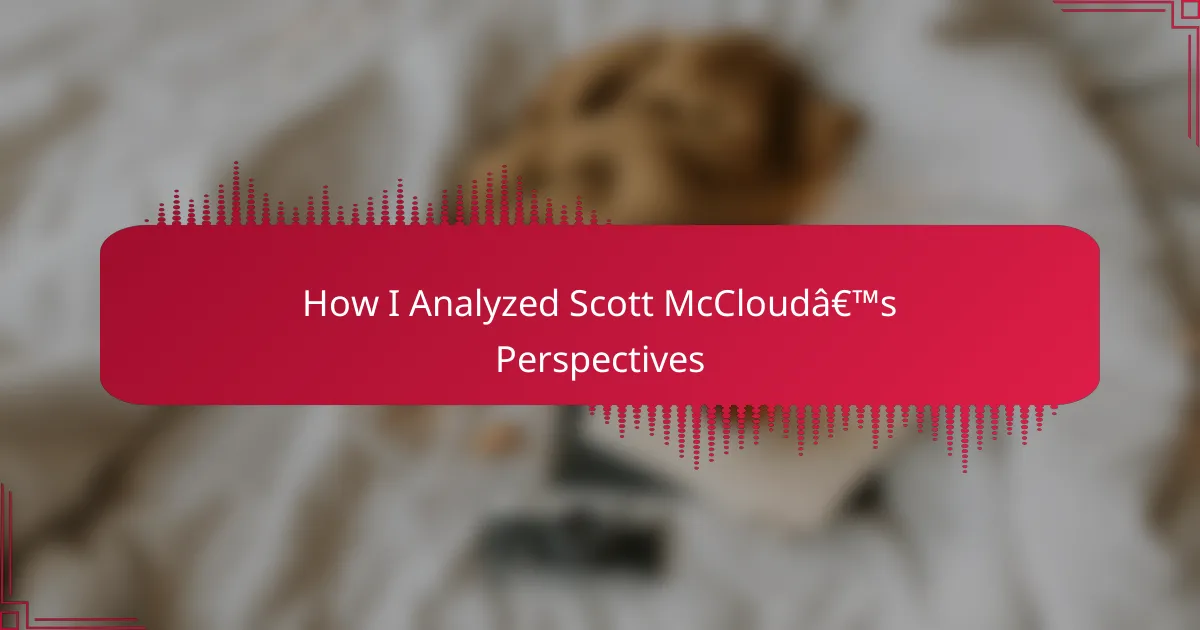Key takeaways
- Resources such as books, online courses, and forums significantly enhance comic book authors’ skills and foster a supportive community.
- Scott McCloud’s work emphasizes the balance between visuals and narratives, encouraging readers to engage actively with the storytelling process.
- Analyzing visual elements, panel layout, and pacing can deepen the understanding of comics and enhance emotional impact.
- Applying McCloud’s concepts like “closure” allows creators to invite readers to contribute to narrative interpretation, enriching the storytelling experience.
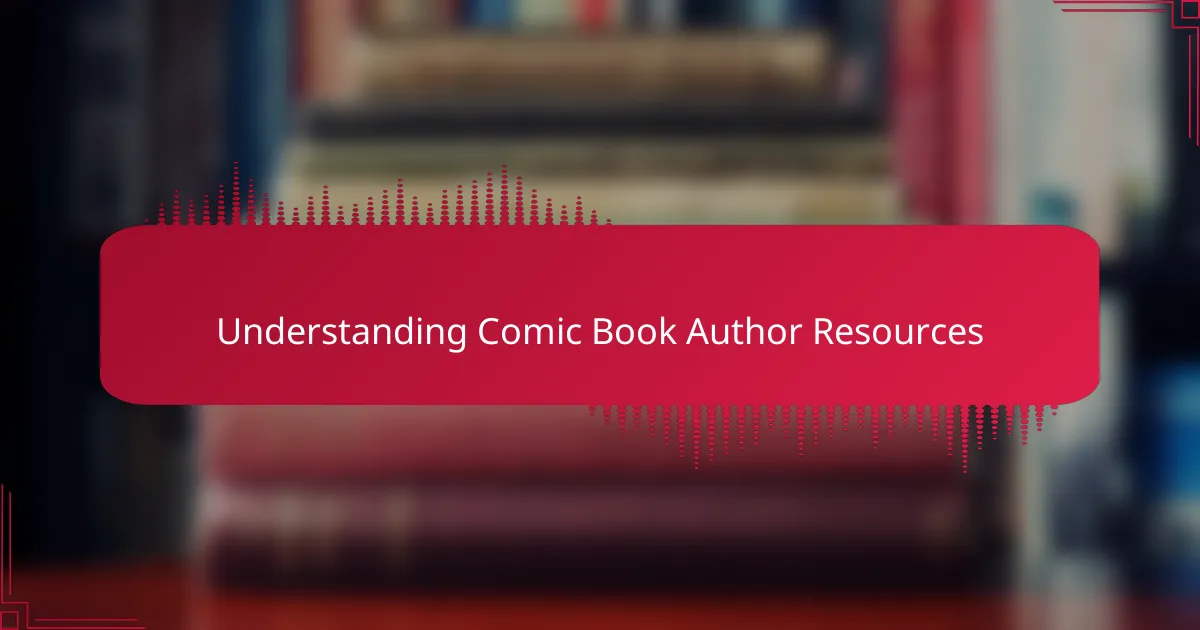
Understanding Comic Book Author Resources
Understanding the available resources for comic book authors is critical for anyone looking to succeed in the industry. From practical guides on visual storytelling to forums that encourage feedback, these tools can significantly enhance a creator’s skills. Personally, I found that immersing myself in various resources not only improved my craft but also connected me with a supportive community of fellow creators who share the same passion.
While exploring Scott McCloud’s perspectives, I realized how essential it is to understand the theory behind comic creation. His insights taught me about the balance between visuals and narratives, which was a game-changer in my own projects. Engaging with these resources has not only informed my work but has also sparked a deeper appreciation for the art form.
| Resource Type | Description |
|---|---|
| Books | Comprehensive guides covering theory and practice, such as Scott McCloud’s works. |
| Online Courses | Interactive platforms offering lessons on storytelling and comic creation. |
| Forums | Community spaces for sharing work, asking for feedback, and networking with fellow authors. |
| Workshops | Hands-on experiences where authors can collaborate and learn directly from industry professionals. |
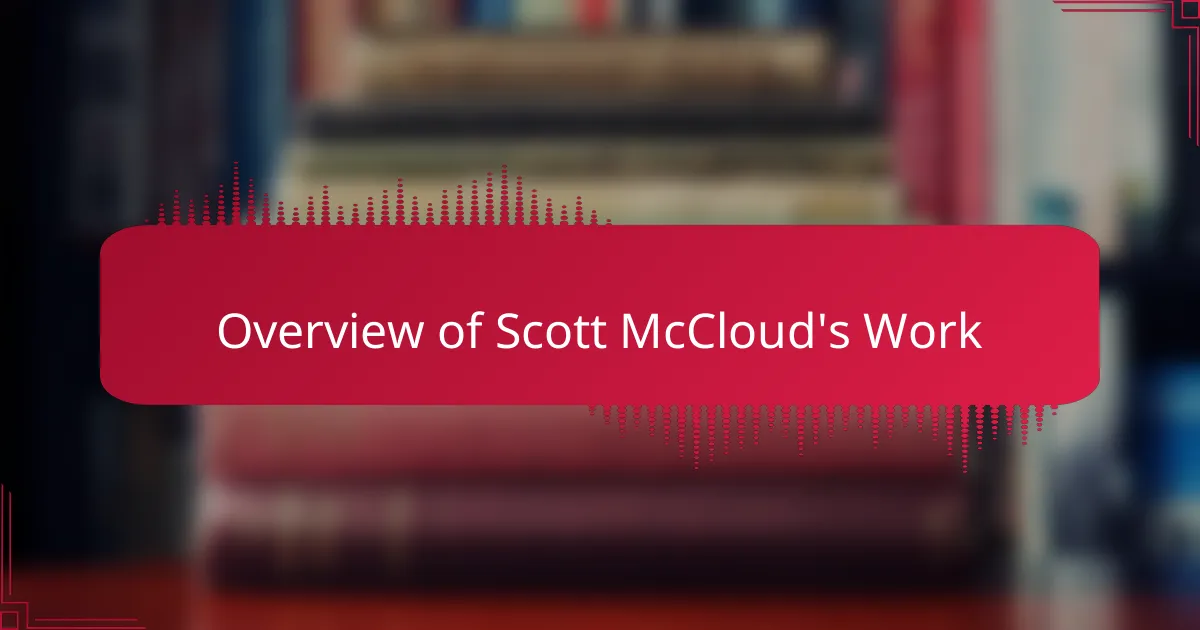
Overview of Scott McCloud’s Work
Scott McCloud is a pivotal figure in the world of comics, and his insightful works have profoundly shaped how I understand the medium. His most famous book, “Understanding Comics,” offers a deep exploration into the nature of comics and the mechanics behind visual storytelling. I remember the first time I read it; it felt like a revelation, making me appreciate the artistry and thought that goes into each panel.
McCloud’s unique approach combines theory with practical examples, making complex ideas accessible. He expertly bridges the gap between comics and other forms of art, which I found incredibly inspiring for my own work. Reflecting on his ideas pushed me to analyze not just the visuals in comics but also the underlying narratives and emotions they convey.
- Understanding Comics: This book breaks down the elements of comics, discussing how they communicate meaning.
- The Invisible Art: McCloud emphasizes the importance of the reader’s role in interpreting comics.
- Time and Comics: He explores how time is represented in sequential art, an aspect that frequently influences my storytelling.
- Visual Language: McCloud discusses how the combination of images and text creates a unique language, enhancing the emotional depth and impact of the narrative.
- Cognition and Emotion: His analysis of how readers process comic art has encouraged me to consider the audience’s perspective in my writing.
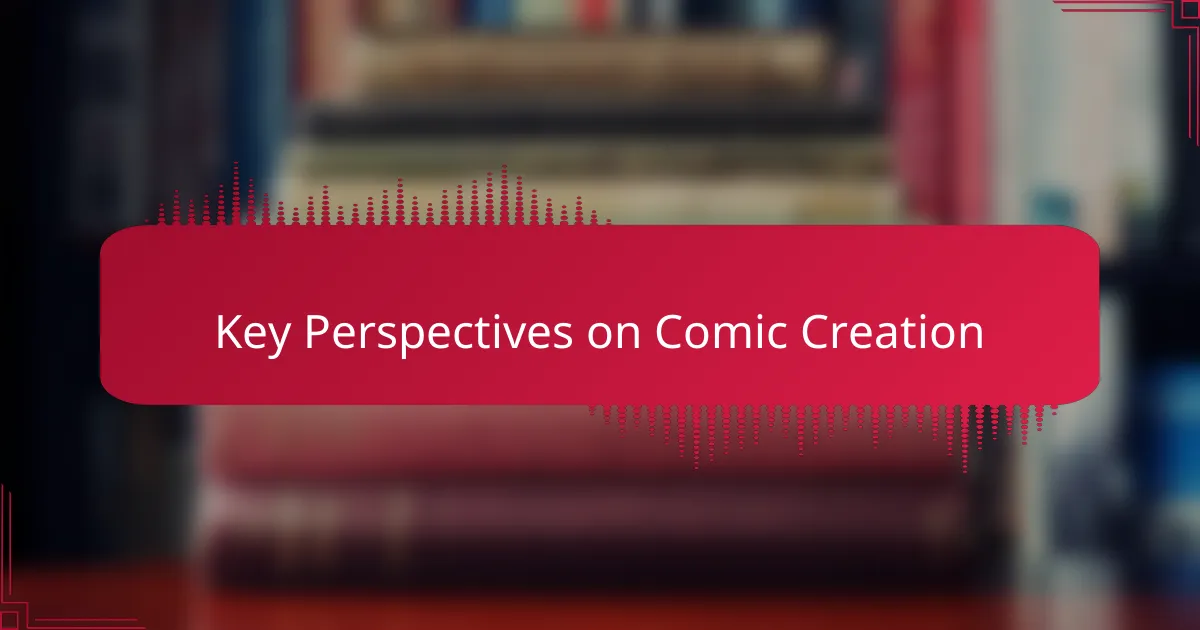
Key Perspectives on Comic Creation
One key perspective that stands out in Scott McCloud’s work is the interplay between visuals and narratives. I often find myself reflecting on how each panel not only tells a part of the story but also evokes specific emotions. Have you ever paused on a page, feeling the weight of a silence in a single image? This really struck me during my own creative process, as I learned to weave together images and words to create a more impactful experience for the reader.
Another crucial aspect McCloud emphasizes is the importance of the reader’s role in interpreting comics. It’s fascinating to consider that while a creator might intend a certain meaning, the audience’s perception can vary widely. I remember sharing my first comic with friends and discovering how their interpretations opened my eyes to new dimensions of my work. This engagement has encouraged me to invite readers into the storytelling process, making them active participants rather than passive observers.
Lastly, McCloud dives into the significance of time within sequential art, a concept that profoundly influences pacing in my stories. I’ve experimented with the rhythm of panels to create tension or provide relief, simulating the feeling of time passing. Have you ever noticed how a well-placed pause can completely change your emotional experience of the story? This understanding has allowed me to manipulate time creatively, leaving a lasting impact on my audience.
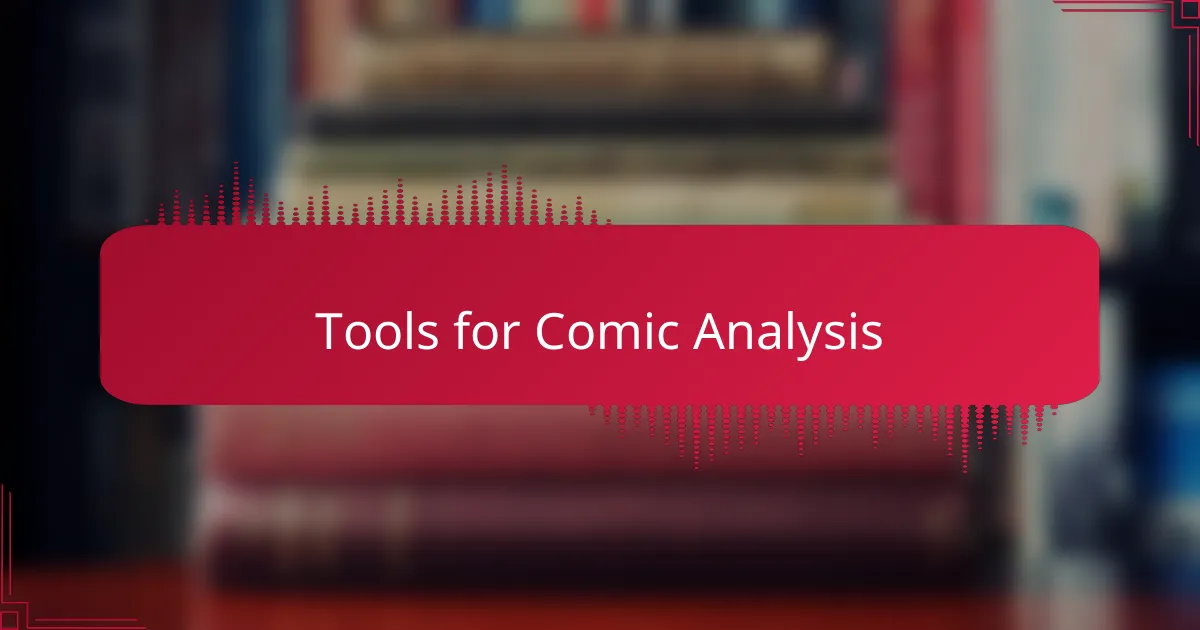
Tools for Comic Analysis
When I dive into comic analysis, I’ve found that a few tools shine brightly in helping to understand the medium on a deeper level. Tools like Scott McCloud’s “Understanding Comics” have not only shaped my perspective but have also given me the vocabulary to articulate what I see on the page. I remember the first time I used his concepts to analyze a comic; it felt like uncovering a hidden layer that transformed my appreciation for the art form.
Another valuable resource is the use of visual analysis techniques, which dissect elements like panel layout, color choices, and line quality. These details can drastically impact the storytelling, and I find that examining these aspects often leads to new interpretations. For example, while analyzing a comic, I once noticed how the color palette changed in relation to the protagonist’s emotional journey—this personal insight resonated deeply with my reading experience.
Comparing various comic analysis tools can be quite enlightening. Below is a simple comparison table that illustrates a few of the most notable analysis resources:
| Tool | Description |
|---|---|
| Scott McCloud’s “Understanding Comics” | A foundational text that offers insights on visual language and storytelling in comics. |
| Visual Analysis Techniques | Focuses on dissecting art elements such as color and layout to explore deeper meanings. |
| Comic Book Studies Journals | Peer-reviewed articles that provide academic perspectives and critical analyses of comics. |
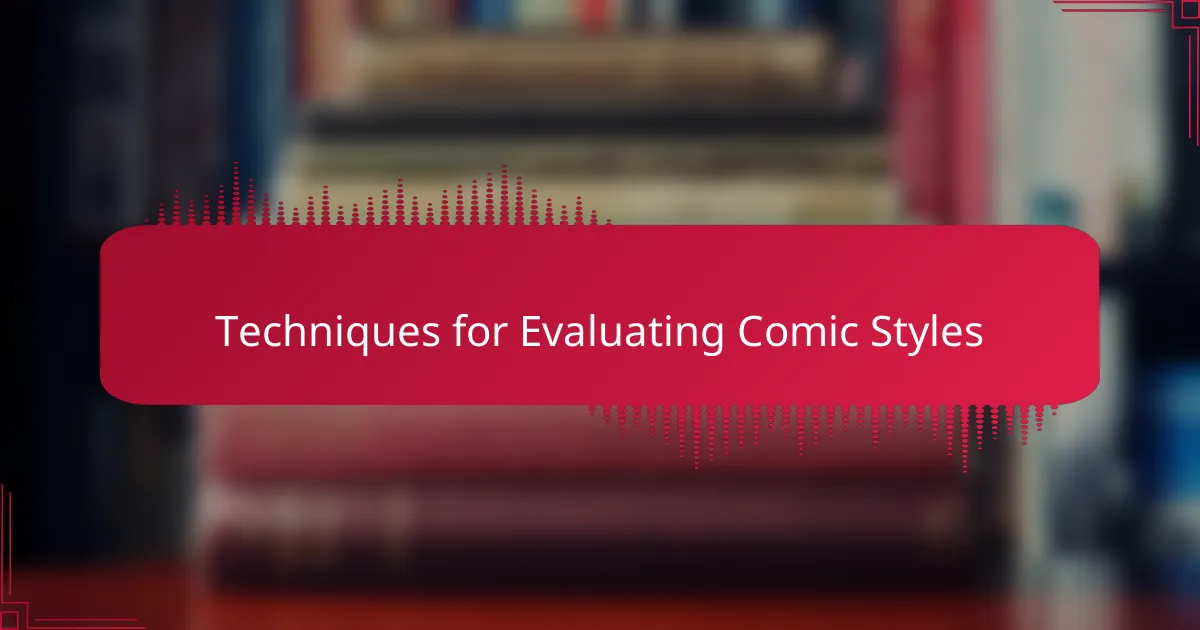
Techniques for Evaluating Comic Styles
When evaluating comic styles, one effective technique is to closely examine the visual elements, such as line work and color palettes. I’ve always felt that a comic’s art style sets the emotional tone for the narrative. For instance, I remember diving into a graphic novel where the stark black-and-white art contrasted with the vibrant, chaotic story, creating a tension that stuck with me long after I turned the last page.
Another essential technique involves analyzing the pacing and panel layout. I often reflect on my reading experiences; some comics use dynamic layouts to propel the story forward, while others favor a more structured approach that enhances emotional moments. It’s fascinating how these choices affect how we perceive and connect with the characters.
- Focus on the visual language: Observe how colors and lines convey emotions or themes.
- Analyze panel transitions: Note how the arrangement impacts storytelling and reader engagement.
- Study character design: Consider how visual traits reflect personalities and roles within the story.
- Explore typography: Investigate how font choices enhance dialogue and emotional weight.
- Reflect on reader response: Think about how different styles resonate with you personally and shape your experience.

Personal Insights from McCloud’s Advice
Scott McCloud’s insights on the art of comics have significantly impacted my understanding of the medium. His emphasis on how images and words work together to convey meaning resonates deeply with my experience as both a reader and a creator. I remember the first time I applied his ideas about visual storytelling in my own work; it felt like unlocking a new level of creativity.
In analyzing McCloud’s perspectives, I found a balance between theory and practical application. For instance, when he discusses the concept of “closure,” I realized how crucial it is to engage readers by allowing them to fill in the gaps. Reflecting on my own projects, I often think, “How can I encourage my audience to become active participants?” This question has transformed my approach to narrative design.
| Aspect | McCloud’s Perspective |
|---|---|
| Visual Storytelling | Combines images and text for deeper meaning |
| Closure | Readers fill in missing information, making them active participants |
| Time and Space | Arranging panels creates the flow of time in storytelling |
| Artist’s Voice | Unique styles communicate different emotions and messages |

Applying McCloud’s Perspectives to Your Work
Applying McCloud’s perspectives to my work has led me to a profound understanding of the delicate balance between visuals and storytelling. I remember grappling with a scene where a simple change in panel arrangement transformed the emotional impact entirely. Have you experienced a moment in your storytelling where the visuals profoundly resonated with the narrative? Realizing this connection helped me develop a keen eye for how each element contributes to the overall feeling of a comic.
The concept of “closure,” which McCloud emphasizes, is something I’ve thoroughly integrated into my creative process. It intrigues me how readers can fill in the gaps between panels, actively participating in the story. I recall the excitement of watching a friend read one of my comics and seeing her interpretation diverge from my intent. That moment reinforced the idea that inviting readers to become co-creators can enrich the narrative experience significantly.
Exploring the representation of time in comics has also been a game-changer for me. I’ve experimented with varying panel lengths and layouts to manipulate the pace, creating suspense or allowing reflective moments. Have you ever noticed how a deliberately placed pause can shift the entire tone of your story? Understanding this has empowered me to control the emotional journey of my readers, ensuring that they feel every heartbeat of the narrative.
